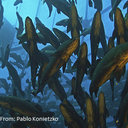Purification and characterization of macrodontain I, a cysteine peptidase from unripe fruits of Pseudananas macrodontes (Morr.) harms (Bromeliaceae).
Maneno muhimu
Kikemikali
A new papain-like cysteine peptidase isolated from fruits of Pseudananas macrodontes (Morr.) Harms, a species closely related to pineapple (Ananas comosus L.), has been purified and characterized. The enzyme, named macrodontain I, is the main proteolytic component present in fruit extracts and was purified by acetone fractionation followed by anion-exchange chromatography. Separation was improved by selecting both an adequate pH value and a narrow saline gradient. Optimum pH range (more than 90% of maximum activity with casein) was achieved at pH 6.1-8.5. Homogeneity of the enzyme was confirmed by bidimensional electrophoresis and mass spectroscopy (MS). Molecular mass of the enzyme was 23,459 (MS) and its isoelectric point was 6.1. The alanine, glutamine, and tyrosine derivatives were strongly preferred when the enzyme was assayed on N-alpha-CBZ-l-amino acid p-nitrophenyl esters. The N-terminal sequence of macrodontain (by comparison with the N-terminus of 30 plant proteases with more than 50% homology) showed a great deal of sequence similarity to the other pineapple-stem-derived cysteine endopeptidases, being 85.7, 85. 2, and 77.8% identical to comosain, stem bromelain, and ananain, respectively. It seems clear that the Bromeliaceae endopeptidases are more closely related to each other than to other members of the papain family, suggesting relatively recent divergence.


